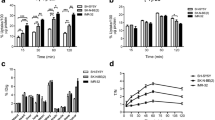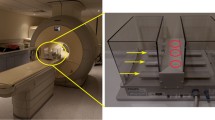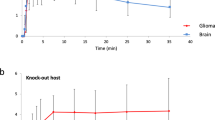Abstract
Purpose
TH-MYCN transgenic mice represent a valuable preclinical model of neuroblastoma. Current methods to study tumor progression in these mice are inaccurate or invasive, limiting the potential of this murine model. The aim of our study was to assess the potential of small animal positron emission tomography (SA-PET) to study neuroblastoma progression in TH-MYCN mice.
Procedure
Serial SA-PET scans using the tracer 2-deoxy-2-[18F]fluoro-d-glucose (18F-FDG) have been performed in TH-MYCN mice. Image analysis of tumor progression has been compared with ex vivo evaluation of tumor volumes and histological features.
Results
[18F]FDG-SA-PET allowed to detect early staged tumors in almost 100 % of TH-MYCN mice positive for disease. Image analysis of tumor evolution reflected the modifications of the tumor volume, histological features, and malignancy during disease progression. Image analysis of TH-MYCN mice undergoing chemotherapy treatment against neuroblastoma provided information on drug-induced alterations in tumor metabolic activity.
Conclusions
These data show for the first time that [18F]FDG-SA-PET is a useful tool to study neuroblastoma presence and progression in TH-MYCN transgenic mice.





Similar content being viewed by others
References
Brodeur GM (2003) Neuroblastoma: biological insights into a clinical enigma. Nat Rev Cancer 3:203–216
Howman-Giles R, Shaw PJ, Uren RF et al (2007) Neuroblastoma and other neuroendocrine tumors. Semin Nucl Med 37:286–302
Kushner BH (2004) Neuroblastoma: a disease requiring a multitude of imaging studies. J Nucl Med 45:1172–1188
Melzer HI, Coppenrath E, Schmid I et al (2011) ¹²³I-MIBG scintigraphy/SPECT versus 18F-FDG PET in paediatric neuroblastoma. Eur J Nucl Med Mol Imaging 38:1648–1658
Sharp SE, Shulkin BL, Gelfand MJ et al (2009) 123I-MIBG scintigraphy and 18F-FDG PET in neuroblastoma. J Nucl Med 50:1237–1243
Papathanasiou ND, Gaze MN, Sullivan K et al (2011) 18F-FDG PET/CT and 123I-metaiodobenzylguanidine imaging in high-risk neuroblastoma: diagnostic comparison and survival analysis. J Nucl Med 52:519–525
Franzius C (2010) FDG-PET/CT in pediatric solid tumors. Q J Nucl Med Mol Imaging 54:401–410
Piccardo A, Lopci E, Conte M et al (2012) Comparison of 18F-dopa PET/CT and 123I-MIBG scintigraphy in stage 3 and 4 neuroblastoma: a pilot study. Eur J Nucl Med Mol Imaging 39:57–71
Kroiss A, Putzer D, Uprimny C, Decristoforo C et al (2011) Functional imaging in phaeochromocytoma and neuroblastoma with 68 Ga-DOTA-Tyr 3-octreotide positron emission tomography and 123I-metaiodobenzylguanidine. Eur J Nucl Med Mol Imaging 38:865–873
Weiss WA, Aldape K, Mohapatra G, Feuerstein BG, Bishop JM (1997) Targeted expression of MYCN causes neuroblastoma in transgenic mice. EMBO J 16:2985–2995
Moore HC, Wood KM, Jackson MS et al (2008) Histological profile of tumors from MYCN transgenic mice. J Clin Pathol 61:1098–1103
Weiss WA, Godfrey T, Francisco C, Bishop JM (2000) Genome-wide screen for allelic imbalance in a mouse model for neuroblastoma. Cancer Res 609:2483–2487
Hackett CS, Hodgson JG, Law ME et al (2003) Genomewide array CGH analysis of murine neuroblastoma reveals distinct genomic aberrations which parallel those in human tumors. Cancer Res 6317:5266–5273
Norris MD, Burkhart CA, Marshall GM, Weiss WA, Haber M (2000) Expression of N-myc and MRP genes and their relationship to N-myc gene dosage and tumor formation in a murine neuroblastoma model. Med Pediatr Oncol 356:585–589
Terrile M, Bryan K, Vaughan L et al (2011) miRNA expression profiling of the murine TH-MYCN neuroblastoma model reveals similarities with human tumors and identifies novel candidate miRNAs. PLoS One 6:e28356
Chesler L, Goldenberg DD, Seales IT et al (2007) Malignant progression and blockade of angiogenesis in a murine transgenic model of neuroblastoma. Cancer Res 67:9435–9442
Tai YC, Ruangma A, Rowland D et al (2005) Performance evaluation of the microPET focus: a third generation microPET scanner dedicated to animal imaging. J Nucl Med 46:455–463
Spinelli AE, D’Ambrosio D, Pettinato C et al (2007) Performance evaluation of a small animal PET scanner. Spatial resolution characterization using 18F and 11C. Nucl Inst Methods Phys Res A 571:215–218
Wang J, Maurer L (2005) Positron emission tomography: applications in drug discovery and drug development. Curr Top Med Chem 5:1053–1075
Hwang RF, Yokoi K, Bucana CD et al (2003) Inhibition of platelet-derived growth factor receptor phosphorylation by STI571 (Gleevec) reduces growth and metastasis of human pancreatic carcinoma in an orthotopic nude mouse model. Clin Cancer Res 9:6534–6544
Aide N, Louis MH, Dutoit S et al (2007) Improvement of semi-quantitative small-animal PET data with recovery coefficients: a phantom and rat study. Nucl Med Commun 28:813–822
Hoffman EJ, Huang SC, Phelps ME (1979) Quantitation in positron emission computed tomography: 1. Effect of object size. J Comput Assist Tomogr 3:299–308
Zhang H, Inoue T, Alyafei S et al (2001) Tumor detectability in 2-dimensional and 3-dimensional positron emission tomography using the SET-2400W: a phantom study. Nucl Med Commun 22:305–314
Ladenstein R, Valteau-Couanet D, Brock P et al (2010) Randomized trial of prophylactic granulocyte colony-stimulating factor during rapid COJEC induction in pediatric patients with high-risk neuroblastoma: the European HR-NBL1/SIOPEN study. J Clin Oncol 21:3516–3524
Tylski P, Stute S, Grotus N et al (2010) Comparative assessment of methods for estimating tumor volume and standardized uptake value in 18F-FDG PET. J Nucl Med 51:268–276
Nestle U, Kremp S, Schaefer-Schuler A et al (2005) Comparison of different methods for delineation of 18F-FDG PET-positive tissue for target volume definition in radiotherapy of patients with non-small cell lung cancer. J Nucl Med 46:1342–1348
Maris JM (2010) Recent advances in neuroblastoma. N Engl J Med 36223:2202–2211
Teitz T, Stanke JJ, Federico S et al (2011) Preclinical models for neuroblastoma: establishing a baseline for treatment. PLoS One 29(6):e19133
Accorsi R, Morowitz MJ, Charron M et al (2003) Pinhole imaging of 131I-metaiodobenzylguanidine (131I-MIBG) in an animal model of neuroblastoma. Pediatr Radiol 33:688–692
Hackett CS, Hodgson JG, Law ME et al (2003) Genome-wide array CGH analysis of murine neuroblastoma reveals distinct genomic aberrations which parallel those in human tumors. Cancer Res 17:5266–5273
Hansford LM, Thomas WD, Keating JM et al (2004) Mechanisms of embryonal tumor initiation: distinct roles for MycN expression and MYCN amplification. Proc Natl Acad Sci U S A 101:12664–12669
Qing G, Skuli N, Mayes PA et al (2010) Combinatorial regulation of neuroblastoma tumor progression by N-Myc and hypoxia inducible factor HIF-1alpha. Cancer Res 70(24):10351–10361, Dec 15
Chen QR, Song YK, Yu LR et al (2010) Global genomic and proteomic analysis identifies biological pathways related to high-risk neuroblastoma. J Proteome Res 9:373–382, Jan
Acknowledgments
We thank Dr. Pasquale Chieco and the Center for Applied Biomedical Research (CRBA), S. Orsola-Malpighi University Hospital, Via Massarenti 9, 40138 Bologna, Italy for support and expert assistance with histology and immunohistochemistry. We thank Prof. Hein te Riele for editorial and scientific suggestions. We thank the Italian Foundation for Neuroblastoma Research, AIRC, AGEOP, and NIH R01CA102321 for support.
Conflict of Interest
The authors have no conflict of interest to declare.
Author information
Authors and Affiliations
Corresponding author
Additional information
Carmelo Quarta, Erika Cantelli, Roberto Tonelli, and Stefano Fanti contributed equally to this work.
Electronic Supplementary Material
Below is the link to the electronic supplementary material.
ESM 1
(PDF 286 kb)
Rights and permissions
About this article
Cite this article
Quarta, C., Cantelli, E., Nanni, C. et al. Molecular Imaging of Neuroblastoma Progression in TH-MYCN Transgenic Mice. Mol Imaging Biol 15, 194–202 (2013). https://doi.org/10.1007/s11307-012-0576-9
Published:
Issue Date:
DOI: https://doi.org/10.1007/s11307-012-0576-9




